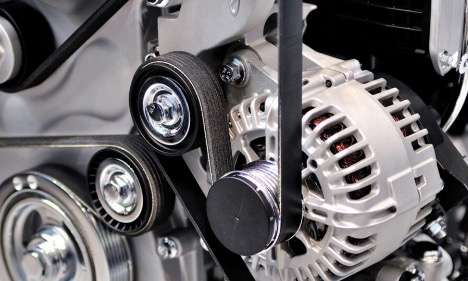Last updated on June 27th, 2023 at 01:40 pm
Serpentine belt noise is the last sound you want to hear from your vehicle. The squeals and chirps are annoying and embarrassing. They also reduce your confidence while driving. These sounds may sometimes disappear or linger. But one thing is certain -serpentine belt sounds are due to several causes, such as a loosed belt, a worn-out belt, a bad tensioner, or one of the pulleys being misaligned.
Often, most people assume the noise is due to a bad serpentine belt. But that’s not always the case, and assumptions are ineffective in problem-solving. Hence, the need for a proper diagnosis that will determine the root cause of the noise. With an accurate diagnosis, you can proffer effective and lasting solutions to the noise problem.
This article will show you how to diagnose serpentine belt noise, discover the source with pinpoint accuracy and know what to do afterward.
Let’s start with the basis.
Related: How to Fix a Squeaky Belt with Soap
How to Identify Serpentine Noise
Serpentine belt noises are easy to identify, because they are audible with high pitches. Since there are other sounds that your vehicle may create while in motion or stationary, which are quite loud but aren’t from the serpentine belt, it’s essential to identify serpentine belt sounds.
Serpentine belt noises are unique because they make squeal or chirp sounds. So, whenever you hear squeals or chirps from your vehicle, check if the sound is coming from the front of the vehicle or beneath the engine’s hood. If yes, and it’s a squealing sound, then it’s from the serpentine belt within the engine, indicating something is wrong. It could be loose, worn out, not having a firm grip on the pulleys, or loss of tension in the entire system. In this case, the belt is the problem and needs urgent replacement. However, a complete diagnosis will reveal if the tensioner is also a problem and requires fixing or replacement.
If the engine is only creating chirping sounds, then the belt is not the problem but the pulleys and tensioner. The tensioner may be bad, or the pulleys are misaligned.
How to Test or Diagnose Serpentine Belt Noise
Now that you can confirm that your serpentine belt is the chief culprit of the occasional or persistent noise from your vehicle’s engine, it’s time to diagnose the problem. This diagnosis will help you determine the cause of the noise and proffer solutions based on informed knowledge and not on assumptions.
Diagnose your Serpentine Belt Noise with the following steps.
Step 1: Pull over the car if you are on the road and turned off the engine and the keys then open its bonnet.
Step 2: Locate the serpentine belt around the alternator and check it properly for any visible signs of damage, wear, and tear or if the belt is loose or has slipped out of one of the pulleys.
Step 3: Perform the spray bottle test by spraying water on the belt. If the noise grows louder on spraying with water, the tensioner and belt are faulty and demand replacement. If the noise goes away and returns after a while, then it’s a pulley-misalignment problem.
Step 4: Is the weather cold? This could be the reason for the squeals, and it’s not a serious problem because the car will soon warm up, and the belt squeal will go away. This diagnosis should be easy.
Step 5: Check the tensioner and pulleys for any distortions or misalignments. Sometimes, the problem is not from the belt but the other mechanical components attached to it.
From the test and diagnosis, you can be certain if the serpentine belt or tensioner needs replacement or the services of a mechanic to fix other mechanical problems affecting the belt and creating the squeals. In either case, you’ll still have to call a mechanic to get the job done, as belt problems are hardly DIY tasks.
Can you Spray WD-40 on the Serpentine Belt?
Yes, you can use WD-40 oil to make the squealing sound go away if the belt is the only problem. Yet, you would want to be certain that the WD-40 you are using is an anti-slip dressing type, not the regular WD-40 because they can damage the belt in the long run.
Is It Safe to Drive with Noisy Serpentine Belt?
A noisy serpentine belt is a sign of a potential belt failure. When the belt inevitably fails, many vital components of your car that rely on the belt’s functionality for power, like the power steering, air conditioner, and battery, will cease to function. Therefore, it’s unsafe to drive around with that strange noise.
How Can I Tell If My Serpentine Belt Needs to be Replaced?
There are telltale signs of a serpentine belt that needs replacement. When you examine your serpentine belt and discover even slight damage, it needs replacement because it will soon fail. Wear, tear, and damages caused by heat or using antifreeze will be visible on the belt, and when you spot them, start making arrangements for a replacement.
If your serpentine belt has also exceeded or is approaching the number of predicted miles it can achieve, then it’s calling for a replacement.
How Do You Quiet a Noisy Serpentine Belt?
Not all noisy serpentine belts will require replacement. After a thorough examination of the belt and it looks good, then it doesn’t need a replacement. But if the noise is persistent, stop it by spraying an anti-slip belt dressing on the belt. Then start the engine and observe the sound. If it persists, you need to check the tensioner and pulleys for any damages and call your mechanic to help you fix them. Most likely, the tensioner will be replaced if it’s severely damaged.
Conclusion
There are many reasons why your serpentine belt may squeal, chirp, or make other awkward noises. Knowing how to diagnose the noise can help you discover its root cause and provide a solution to it. Often, a quick fix like spraying an anti-slip belt dressing will solve the problem, and depending on your diagnosis, you may have to replace the belt or fix other challenges with the pulleys and tensioner. As a thumb rule, always refer to the car’s manual and consult a mechanic in areas you’re having difficulties.

Hi dear, my name is Jeffery Ekweghi, and I am a certified mechanic and autobody parts technician. I created this site to share my expertise and experience with car lovers looking to resolve their car-related issues. I am certified in private cars and heavy-duty commercial vehicles. I have worked as a mechanic since 2015 and have experience in vehicle brands like Subaru, Jeep, Toyota, TATA, BMW, Mazda, Honda, Nissan, Kia, TVs, and Others; however, I primarily specialize in Toyota vehicles.













